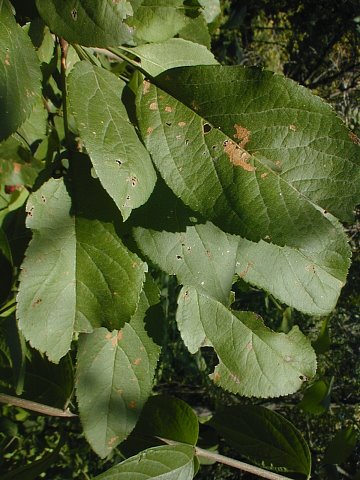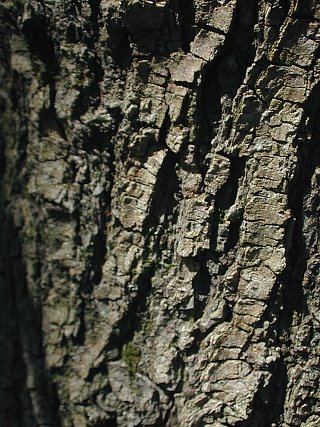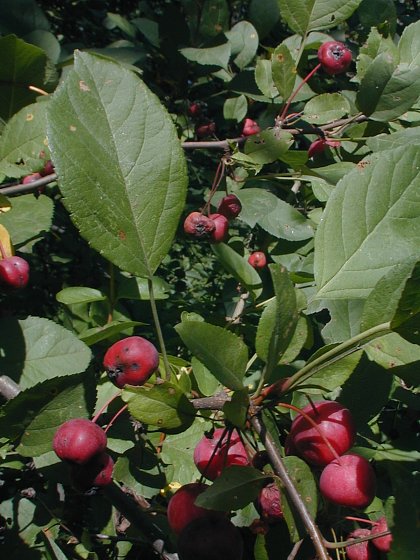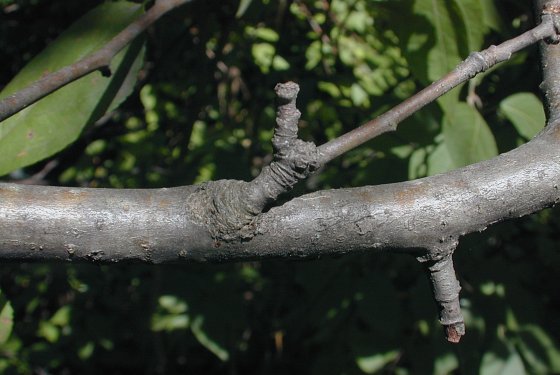
Corymbs of 3-10 flowers are produced near the axils of the leaves on short spur-shoots. The flowers are pinkish in bud, but become white when they bloom. Each flower is 1½-2" across, consisting of 5 white petals, 5 light green sepals that are joined together at the base, about 20 stamens with pale yellow anthers, 4-5 styles, and an inferior ovary. The sepals are about 1/3" (8 mm.) in length, lanceolate-triangular in shape, and short-pubescent along their outer surfaces. After the blooming period, withered remnants of the sepals persist on each pome. The floppy pedicels are ¾-2" long, light green to pale red, and sparsely short-pubescent to nearly glabrous. The blooming period occurs during mid- to late-spring for about 2 weeks. Afterwards, the flowers are replaced by fruits that are referred to as 'pomes.' At maturity during late summer or autumn, these pomes are ¾-1" across, more or less globoid in shape, glabrous, and usually bright red (or less often yellow). Each pome has a slight depression where it is joined by the petiole, while its opposite end near the withered sepals has either a slight depression or such a depression is lacking (often the latter). The interior of the pome contains firm white flesh and about 8-10 seeds. No vegetative offsets are produced from the woody root system; this crab apple reproduces by reseeding itself.

Cultivation: Plum-Leaved Crab Apple adapts to full or partial sun, moist to dry-mesic conditions, and a variety of soil types, including loam, clay-loam, silty loam, and sandy loam. It is vulnerable to a variety of disease organisms that can affect the leaves or fruit.
Range & Habitat: The introduced Plum-Leaved Crab Apple has naturalized in Kane County and Champaign County (see Distribution Map). This species has rarely escaped from cultivation in Illinois, although available records may underestimate its occurrence. Plum-Leaved Crab Apple is native to parts of East Asia, including northern China. Typical habitats include overgrown shrubby areas, riverbanks, and fence rows. While this species is rarely cultivated anymore in its original form, it is still used as grafting stock for various apple cultivars.

Faunal Associations: Crab apples (Malus spp.) attract a variety of wildlife. Their flowers are cross-pollinated by bees, including honeybees, bumblebees, mason bees (Osmia), digger bees (Synhalonia), Andrenine bees, and Halictid bees, which feed on nectar and collect pollen. Less common visitors to the flowers are skippers and butterflies (Robertson, 1929; Wilhelm & Rericha, 2017). Other insects feed on the wood, leaves, plant juices, or fruit of these small trees or shrubs. These insects feeders include the larvae of wood-boring beetles, weevils, scarab beetles, plant bugs, aphids, leafhoppers, treehoppers, armored scale insects, mealy bugs, larvae of sawflies, larvae of such moths as Geometer moths, slug caterpillar moths (Limacodidae), owlet moths (Noctuidae), prominent moths (Notodontidae), Sphinx moths, and Tortricid moths. The Insect Table provides a list of these insect feeders.

Vertebrate animals use crab apple trees as a source of shelter and food. The fruit is eaten by such mammals as the American Black Bear, Red Fox, Gray Fox, Opossum, Raccoon, Fox Squirrel, Striped Skunk, White-tailed Deer. White-Tailed Deer also browse on the leafy twigs and the Cottontail Rabbit gnaws on the bark of saplings (Kurz, 2004; Martin et al., 1952/1962). Although the fruits of Plum-leaved Crab Apple are somewhat large to be carried about by birds, they are still pecked at and occasionally eaten by various upland gamebirds and songbirds, including the Bobwhite Quail, Ring-necked Pheasant, Red-bellied Woodpecker, Yellow-bellied Sapsucker (also drills holes in wood for tree sap), Blue Jay, Baltimore Oriole, Orchard Oriole, European Starling, Monk Parakeet (in the Chicago area), Carolina Parakeet (extinct), and Common Grackle. Because of the dense branching structure of these shrubs or small trees, they provide good nesting habitat and cover for various songbirds, including the Orchard Oriole, Northern Mockingbird, Ruby-throated Hummingbird, Yellow-Breasted Chat, American Robin, and Eastern Bluebird (in cavities).
Photographic Location: A shrubby area of Busey Woods in Urbana, Illinois.

Comments: Because so many cultivars of crab apples (Malus spp.) are grown as ornamental shrubs or trees, naturalized specimens of crab apples are often difficult to identify as some hybridization across different species is common. Plum-Leaved Crab Apple can be identified by its relatively robust size, the characteristics of its leaves, and the characteristics of its fruits. For example, the leaves of Plum-Leaved Crab Apple are more hairy than those of Siberian Crab Apple (Malus baccata) and less hairy than those of the cultivated Apple (Malus pumila). Its leaves also lack the lobes that are common on the leaves of native crab apples in Illinois (Malus coronaria & Malus ioensis). The fruits of Plum-Leaved Crab Apple are larger in size than those of Siberian Crab Apple, but they are smaller in size than those of the cultivated Apple. While the fruits of Plum-Leaved Crab Apple are usually red, the fruits of native crab apples in Illinois are usually greenish yellow. Because of its intermediate characteristics, some authorities have proposed that Plum-Leaved Crab Apple may be a naturally occurring hybrid between the Siberian Crab Apple and the cultivated Apple. However, it is currently classified as a distinct species in most taxonomies.